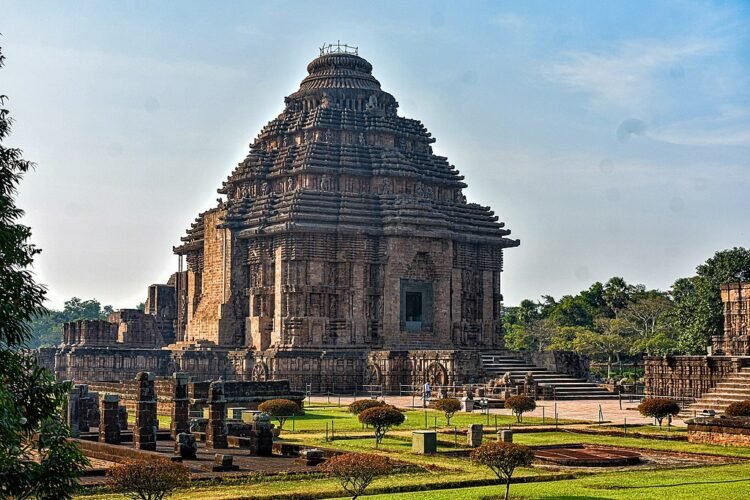No products in the cart.
Konark Is The Finest Example of Kalinga Architecture
Odisha : Secrets of Art & heritage culture
Located on the coastline of Bay of Bengal, Konark is one of the finest beaches of India. Home to iconic Sun Temple, it is part of the Golden Triangle along with Puri and Bhubaneswar. Tourists can have a ride on the picturesque Marine Drive that connects Konark with Puri, visit Ramachandi surrounded by the brackish water of the bay, the Crafts village of Raghurajpur and witness the beautiful sunset at Astaranga.
The Sun Temple Konark
The Sun Temple at Konark is the finest example of Kalinga architecture and a UNESCO World Heritage Site. Built in the 13th Century AD by King Narasimha Deva I, it leaves tourists spellbound with its monolithic structure, symmetry, precision, and intricate detailing of motifs carved on Khondalite stones. Other stones used to build the temple are Chlorite and Laterite. The Sun Temple is popularly known as the ‘Black Pagoda. What we see today are only the remains as the Shikhara (Deula) or the main temple was destroyed in around 1837 AD. Whereas the height of the main temple is stated to be 70 metre, that of the ‘Mukhashala’ (Jagamohan) or the remains is around 39 metre.
The name Konark is derived from the Sanskrit word ‘Kona’or corner and ‘Arka’ meaning Sun in reference to the temple which is dedicated to Sun God Surya. The alignment of the Sun Temple is along the East-West direction. The temple was originally built at the mouth of river Chandrabhaga but the waterline has receded now.
The temple is carefully oriented towards the east so that the first rays of sunrise strike the principal entrance of the structure. It is built in the form of a chariot driven by seven horses on 12 pairs of decorated gigantic wheels, each of 12 feet diameter. The set of horses is meant to represent the seven days of the week, while the 12 pairs of wheels refer to 12 months of the year, each pair representing both the bright and dark fortnights, and the spokes of the wheels serving as sundials When viewed from inland at sunrise, the chariot-shaped temple appears to emerge from the depth of the blue sea carrying the Sun. Apart from the detailed carvings of various motifs on the stones, Konark is famous for the huge erotic sculptures of couples in various stages of courtship and coital intimacy. Due to the continuous blowing of saline wind from the sea, these fast decaying sculptures have been taken out by the ASI and kept in the Konark Archeological Museum.
The museum was set up in 1968 with the purpose of housing the archeological excavations and fallen sculptures from the Sun Temple. The museum has four galleries displaying 260 various antiques which include sculptures, paintings, manuscripts, and fallen parts from the Sun Temple. It is a treasure house for historians and art lovers.
Fairs & Festivals of Konark
Konark is famous for two annual events Magha Saptami Mela at Chandrabhaga and the Konark Festival. The International Sand Art Festival is also held during the Konark Festival and is hosted on the sandy beach of Chandrabhaga every year. While the seven-day long annual Mela takes place on the seventh full-moon day in the month of Magha (January-February), the Konark Festival is organized from 1st to 5th December every year.
During the Konark Festival, the classical and folk-dance performances at the open air Natyashala create an esoteric atmosphere due to the Sun Temple in the backdrop. Eminent artistes of national and international repute participate in the festival and perform Odissi, Kathak, Bharatnatyam, Kuchipudi, Manipuri, Mohiniattam and other classical, folk and tribal dances/music on this enchanting stage.
Odisha’s signature glamping festival Eco-Retreat Odisha is held in Chandrabhaga beach. The eco-friendly glam camps offer guests camping in luxury tents, complemented with a wide array of experiences ranging from jungle trails to water sports, camp-fires to boat rides, cycling tours to adrenaline pumping water sports, and lip-smacking Odia cuisine.
Chandrabhaga Beach
The Konark Beach is named after Chandrabhaga river which joins the sea here. The lengthy stretch of sylvan sands, soothing blue sea and undulating waves makes the beach one of the beautiful places to visit in Konark. A leisurely stroll along the beachside is a lovely experience. Tourists can also enjoy beach activities like sunbath, water sports, surfing and many more. Though this is a great spot for sunbathing, the presence of strong currents makes swimming unsafe. A panoramic view of the sunrise is another captivating attraction of this beach. A lighthouse, close to Chandrabhaga is an added attraction.
Ramachandi Temple & Beach
Located on the banks of Kushabhadra river, Ramachandi Temple is an ancient shrine which is even older than the Sun Temple. It is dedicated to Goddess Ramachandi, believed to be the main deity of Konark.
Raghurajpur
The heritage crafts village of Raghurajpur in Odisha is best known for its Pattachitra. The art form which evolved from the Sri Jagannath Temple in Puri, is used to depict images of Lord Jagannath and his siblings. Artisans at a later time adapted the medium to depict other rural and religious themes. The uniqueness of the village is that every villager is an artisan and every household is a studio-cum-residence.
Astaranga Beach
Astaranga, which means the colours of sunset in local Odia parlance, is Located near the mouth of Devi river. It is a stunning beach that literally immerses everything with reddish hues of the sunset, thereby providing a once in a lifetime experience for visitors.
Access
Air : Biju Patnaik International Airport, Bhubaneswar
Railway Station Bhubaneswar to Puri by Train: 63 km
Road: Bhubaneswar to Konark via Nimapada: 65 km Bhubaneswar to Puri: 68 km ,Puri to Konark on Marine Drive: 36 km
















